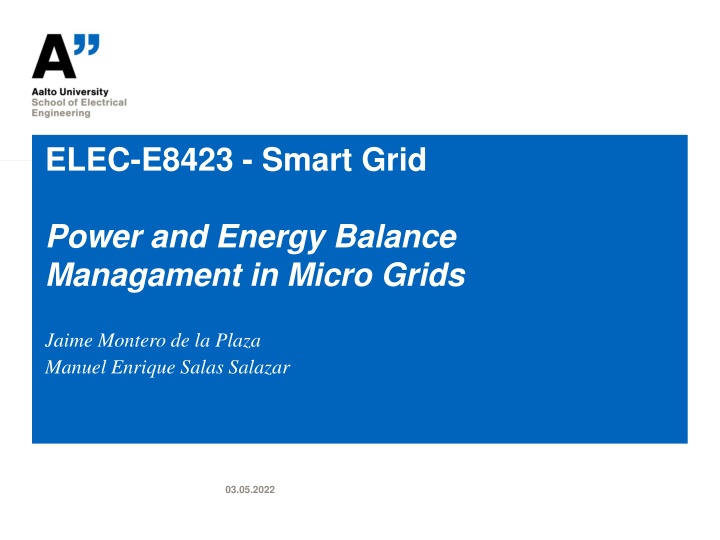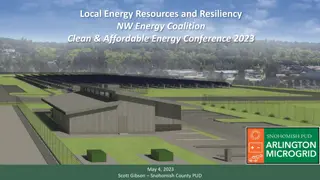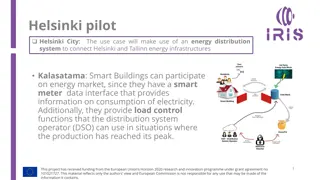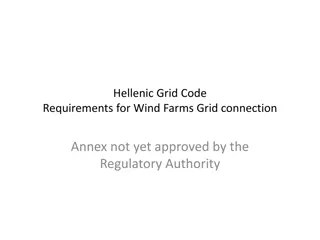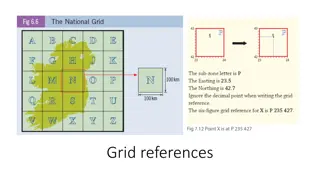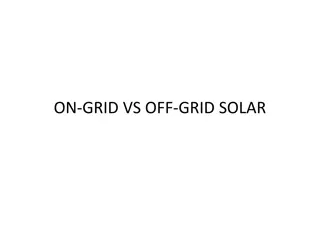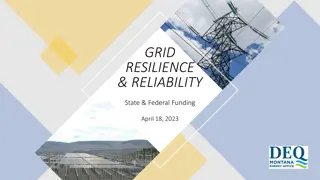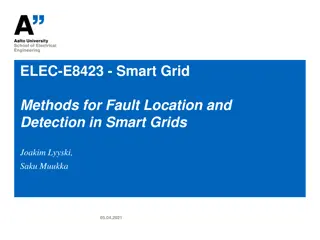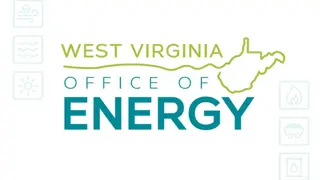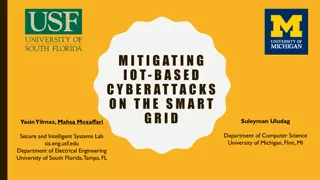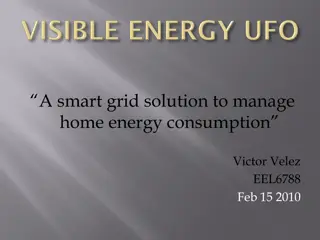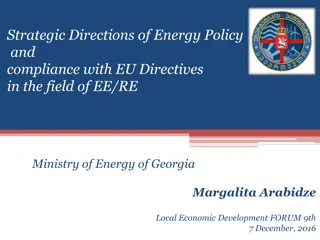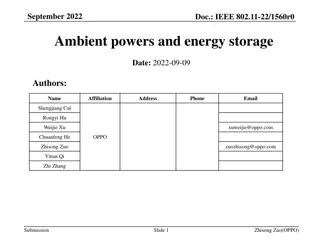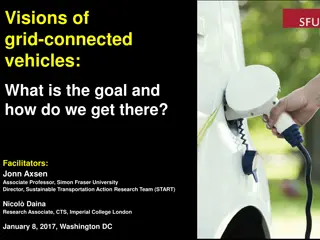Smart Grid Power and Energy Management in Microgrids
Microgrids are local energy systems with control capability, able to operate autonomously or connected to the main grid. Components include renewable and non-renewable sources, energy storage, demand response measures, and control systems. The management of power and energy balance in microgrids involves maintaining stability, optimizing renewable energy use, and ensuring grid-connected or islanded operation. Various control strategies are employed to address challenges such as voltage and frequency control, operating reserves, and system stability.
Download Presentation

Please find below an Image/Link to download the presentation.
The content on the website is provided AS IS for your information and personal use only. It may not be sold, licensed, or shared on other websites without obtaining consent from the author.If you encounter any issues during the download, it is possible that the publisher has removed the file from their server.
You are allowed to download the files provided on this website for personal or commercial use, subject to the condition that they are used lawfully. All files are the property of their respective owners.
The content on the website is provided AS IS for your information and personal use only. It may not be sold, licensed, or shared on other websites without obtaining consent from the author.
E N D
Presentation Transcript
ELEC-E8423 - Smart Grid Power and Energy Balance Managament in Micro Grids Jaime Montero de la Plaza Manuel Enrique Salas Salazar 03.05.2022
Introduction to microgrid Microgrid is a local energy system with control capability, which means it can disconnect from the traditional grid and operate autonomously. Microgrid can connect and disconnect from the grid to enable it to operate in both grid- connected or islanded operation mode. The intention is for the microgrid's generation sources to come from renewable energies, mainly solar and wind energy. Preserving the power and energy of the system in balance while the economical cost of the system keeps being viable is one of the challenging things. 03.05.2022 Page 2
Components of microgrid Energy Supply System Renewable sources: PV, Wind, Small Hydro and Biomass Plant. Non-Renewable: Emergency Generator, Microturbine and Fuel Cell Energy Storage Capacity Batteries, thermal storage Demand Response and Efficiency Measures Minimize overall Energy use Reduce non-critical load when operating isolation Energy Management Systems Real-time response, Predictive and Forecasting an lisis Maintain Balance and Stable Systems Utility Grid Connection Provides backup Loads Controllable Loads: Electric vehicles, Domestic hot water, etc. Critical Loads: Illumination and appliances etc. 03.05.2022 Page 3
Microgrid Controls Grid-Connected Operation: The MG does not participate in the operation of the main electricity system The MG contributes to the stable operation of the electricity system The MG can draw its power from the main grid The MG can supply power to the main grid Controllable load or source Grid-Islanded Operation: The MG should handle the following considerations: Balancing of supply and demand Acceptable power quality Voltage and frequency balance Communication among the MG components 03.05.2022 Page 4
Power and Energy Balance The MG must solve by itself its own ancillary services (voltage and frequency control, operating reserves, black start ). The control scheme must balance energy and power with: Communication based control Time variance and topological connection changes Low inertia and stability issues due to new components. Basic grid-forming control decentralized, distributed, and hierarchical. strategies: centralized, 03.05.2022 Page 5
Power and Energy Balance Infrastructure MGSC, Micro Grid Supervisory Controller. EMS, Energy Management System. PC, Power Converter. DG, Distributed Generation. SG, Smart Grid Higher level operators 03.05.2022 Page 6
Power and Energy Balance Control Centralized: the main responsibility for the maximization of the microgrid value and the optimization of its operation lies with the Micro Grid Supervisory Controller. Decentralized: the main responsibility is given to the Local Controllers, or DGs itself, that collaborate, to production, in order to satisfy the demand. Distributed: the information can be exchanged among Local Controller of the subsystems. compete optimize or their 03.05.2022 Page 7
Power and Energy Balance Control Control Hierarchy Primary dynamics and ensures that the system variables (e.g., voltage and frequency) track their set points. Secondary control: responsible for ensuring power quality and mitigating long term voltage and frequency deviations by determining the set points for the primary control. Tertiary control: is the highest level of control and sets long-term set points depending on the requirements of the host power system based on the information received about the status of the energy sources, market signals, and other system requirements. responds to system control: 03.05.2022 Page 8
Demand and Storage Demand Response by incentives: Offered to customers depending on their behavior in the demand response programs. Direct load control, curtailable service and demand bidding. Demand Response by time: Electricity prices vary according to the cost of generation and the demand for electricity. Customers can then decide on their consumption. Flat pricing, ToU pricing, critical peak pricing and real time pricing. 03.05.2022 Page 9
Demand and Storage Aggregated System: Big dedicated housing in the microgrid. It usually has a large capacity to store a huge amount of energy and high-power output ability. Distributed Energy System: Connected to an individual generation unit or a local load. This option is easier to maintain and escalate. Energy storage system can either closer and connected to the generation side or the load side. Energy Storage energy storage facility with Storage 03.05.2022 Page 10
Micro Grid Strategy The type of control mechanism, demand response and energy storage system will depend on the overall goals and interest of the micro grid. 03.05.2022 Page 11
Benefits Economic Benefits of a MG: The microgrid can act as an initiator of local retail markets. The microgrid can act as a hedging tool against potential risks of price volatility. Technical Benefits of a MG: Energy loss reduction Improved voltage quality Relief of congested networks and devices Enhancement of supply reliability Environmental and Social Benefits of a MG: Shift toward renewable or low-emission fuels Adoption of more energy-efficient energy supply solutions Electrification of remote or underdeveloped areas Creation of new research and job opportunities 03.05.2022 Page 12
Challenges High costs of electricity storages The prediction of renewable energy production and demand is a challenge for optimal system management. Protection System: Sensitivity: Protection system should be able to identify an abnormal condition that exceeds a nominal threshold value Selectivity: Protection system should disconnect only the faulted part of the system in order to minimize fault consequences Speed: Protective relays should respond to abnormal condition in the least possible time in order to avoid damage to equipment and maintain stability 03.05.2022 Page 13
Conclusions Infrastructure and balance of energy and power of a Micro grid depends on its goals set by the different stakeholders. It represents an opportunity for expanding cities and electric networks to incorporate renewable energy sources. Companies and communities in need of a reliable power source are looking to a microgrid system as an efficient, powerful, and ingenious solution. These resilient, emergency-ready systems can lead to fewer blackouts and outages, generate more savings, and reduce dependence on fossil fuels. 03.05.2022 Page 14
Source material used [1] M. Mori, M. Guti rrez, M. Sekav nik, and B. Drobni , Modelling and environmental assessment of a stand-alone micro-grid system in a mountain hut using renewables, Energies, vol. 15, no. 1, 2022, doi: 10.3390/en15010202. [2] G. B. Gharehpetian, H. R. Baghaee, and M. M. Shabestary, Microgrids and Methods of Analysis. 2021. [3] Y. Parag and M. Ainspan, Sustainablemicrogrids: Economic, environmental and social costs and benefits of microgrid deployment, Energy Sustain. Dev., vol. 52, pp. 72 81, 2019, doi: 10.1016/j.esd.2019.07.003. [4] N. Hatziargyriou, Microgrids: Architectures and Control. 2013. [5] M. S. Mahmoud, MICROGRID: Advanced Control Methods and Renewable Energy System Integration. Cambridge, MA: Elsevier, 2017. [6] D. W. Gao, Applications of ESS in Renewable Energy Microgrids. 2015. 03.05.2022 Page 15
